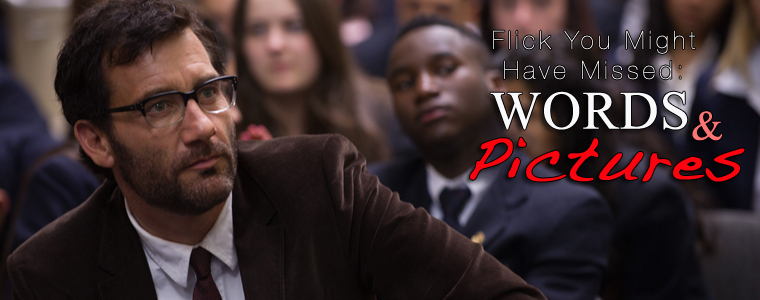O Captain, My Rom-com
by Andrew Collins
The flirting begins with a word game — each player tries to think of a word with more syllables than the last. Jack Marcus (Clive Owen), a top-notch prep school English teacher, has the obvious advantage, but Dina Delsanto (Juliette Binoche) is a stubborn New York art instructor. Their sparring punctuates the dialogue until she strikes a decisive blow with “anti-egalitarianism.”
If you find that scenario at all adorable or appealing, Words and Pictures could be a film for you.
When Dina tells her art class that words are “lies and traps,” in contrast to their paintings, Jack will have none of it. He starts a “war” over which medium is more powerful — words or pictures. Jack challenges Dina to a face-off before the school: her best picture versus a thousand words from him (to challenge the famous saying, “a picture is worth more than a thousand words”).
In many respects Jack could be called a contemporary John Keating (Robin Williams’s famous English teacher in Dead Poets Society) – but with less tenderness and more cheek. One of Jack’s students even affectionately calls him “Captain” after the Whitman poem. Like Keating, he’s the teacher we wish we had, a man passionate to a fault about his craft. He pushes his students to think outside the box, invent new words, and create never-before-read sentences that capture images and ideas, break hearts, and move nations.
He resents how their focus has devolved to fit the numbing climate of the digital world filled with smartphones and social networks. Likewise their concern for English class, he worries, has been debased to nothing more than grades, so that they can get into Ivy League schools.
“Who are you droids? What have you done with my class that you’ve kidnapped and replaced?” he says, in response to a lackadaisical reading of Updike.
In vengeance, he rarely bothers to grade assignments on time and pushes his students relentlessly to savor the written word for its own sake.
Unlike Dead Poets, however, this film is about Jack himself, not about his students. Even though he is an awfully good teacher (and knows it), he has flaws. He goes home every night and drinks himself into a stupor, the purpose of which is twofold: As a washed-up, previously-award-winning author, he struggles with writers’ block; and as a father, he aims to escape the hurt of a divorce and an estranged son. As the film begins, this vice puts his job in jeopardy, which only exacerbates the problem.
Standing across from him, Binoche’s Gina Delsanto has difficulties forced upon her more by fate than personal failing. She suffers from rheumatoid arthritis, a condition that inhibits physical movement and thus her ability to paint. The disease has forced her out of the thriving art scene of New York city into the countryside with her family. Like Jack, she has fallen from higher society’s good graces and finds the trivialities of prep school culture annoying. This makes her the perfect sparring partner for him, and despite their tattered lives they find in each other something worth valuing more than the memory of what they have lost.
“Is a man worth more than his words, a woman worth more than her pictures?” they ask each other. Perhaps not, but in this fleeting life, so prone to take things away, they’ll just have to make do.
Lovers of all aspects of the written word – prose, poetry, vocabulary, etymology – are bound to delight in Words and Pictures. Jack’s antics in this regard add a sweet layer to the film. For instance, when he accuses Dina of being aloof, and explains to her how it is a Dutch word that means to sail into the wind. For the rest of the film we visualize her, with her limp, as a ship pushing into a headwind, confident and undaunted, a wonderfully enriching picture of “aloofness.”
[MINOR SPOILER]
The film ends with the sentimental, predictable, and obvious conclusion of “both/and” instead of “either/or.” Both words and pictures have the power to move us, to make life meaningful, yea verily to complete each other, as the characters’ romance suggests. We call writers “artists” for a reason, after all, and the fact that Words and Pictures is a story told through film – a medium that unites words and moving pictures – drives the point home.
In the end, Words and Pictures offers us a pleasant meditation on two truths: First, the nature of art is such that it can penetrate to the deepest levels of being. Second, life on the far side of one’s prime must be redeemed through relationships. As the potential for worldly accomplishments dim, as dreams and ambition fade, the only things that keep our lives illuminated are beauty for its own sake and purpose through love — flawed and elusive though they may be.








